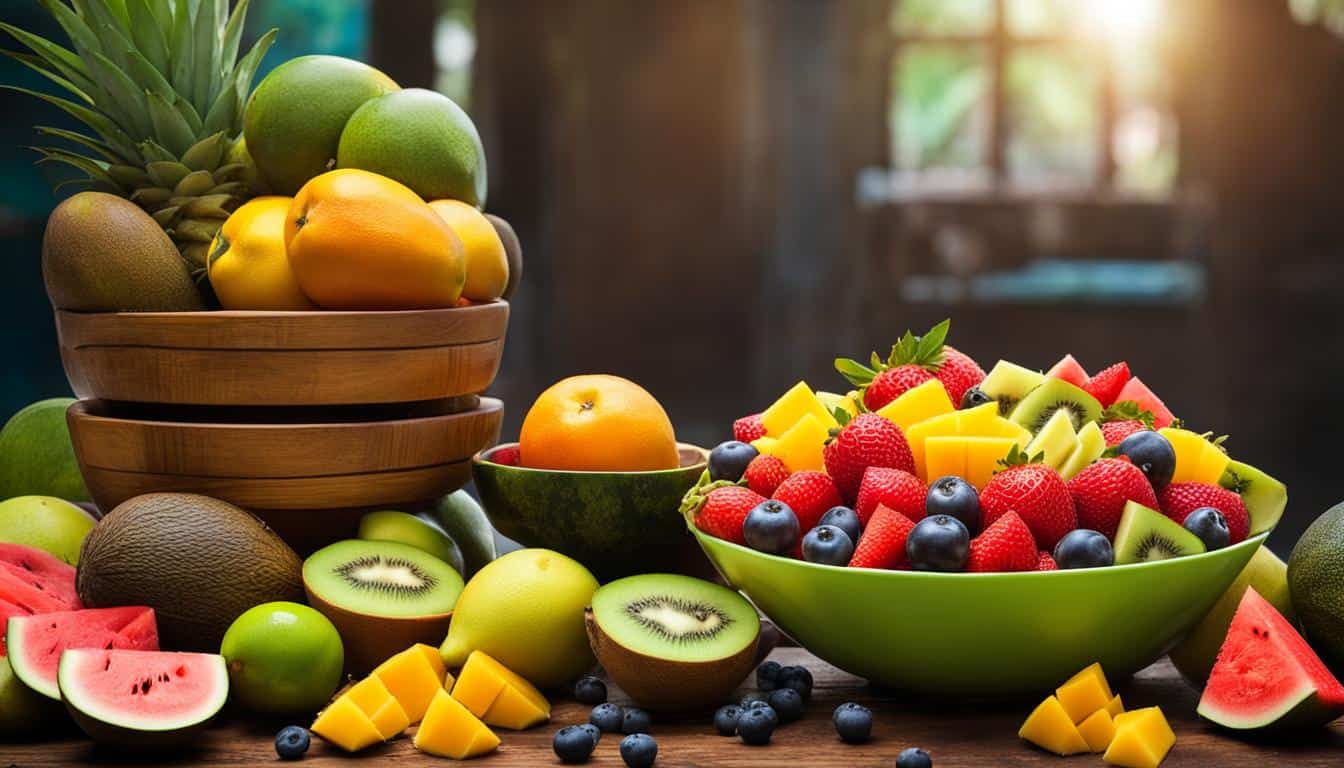Fruits are not only delicious and varied in color, taste, and texture, but they also offer numerous health benefits. They are rich sources of dietary fiber, vitamins, and minerals, making them an excellent choice for children’s snacks. Additionally, learning about fruits helps children expand their vocabulary and cultural knowledge. With this list of fruits in English, you can engage your little ones in fun activities and games that will enhance their language skills while exploring the world of fruits.
Key Takeaways:
- Fruits offer a wide range of flavors, colors, and textures, providing both delicious taste experiences and essential nutrients.
- Learning fruit names in English can help children expand their vocabulary and cultural knowledge.
- Incorporating fruits into a child’s diet from an early age can establish healthy eating habits and provide essential nutrients for growth and development.
- Engaging children in activities and games involving fruits can enhance their language skills and vocabulary.
- Sensory experiences with fruits can deepen children’s understanding and appreciation of different fruits’ taste, texture, and color.
The Many Types and Varieties of Fruit
From the juicy sweetness of a ripe peach to the tartness of a fresh lemon, there is a wide array of fruits to explore in English. Whether you’re looking for familiar fruits like apples, bananas, strawberries, and watermelon, or more exotic options like passion fruit and figs, the world of fruits offers a delightful range of flavors, textures, and colors. To deepen your understanding of fruit varieties, here are some examples:
| Fruit Name | Flavor | Texture | Color |
|---|---|---|---|
| Apple | Sweet and crisp | Crunchy | Red, green, yellow |
| Banana | Sweet and creamy | Soft | Yellow |
| Strawberry | Sweet and tangy | Juicy | Red |
| Watermelon | Sweet and refreshing | Crunchy (rind), juicy (flesh) | Green (rind), red (flesh) |
| Passion Fruit | Tart and tropical | Seedy and pulpy | Purple or yellow |
| Figs | Sweet and earthy | Soft and chewy | Purple or green |
Exploring the different types and varieties of fruits not only introduces you to new flavors but also expands your cultural knowledge. Each fruit has its own unique characteristics, and learning their names in English allows you to appreciate the diversity of fruits and the cultural traditions associated with them. Whether you’re trying a familiar fruit or venturing into the world of exotic varieties, fruit English offers a flavorful journey for your taste buds and language skills.
“The fruit of the tree of knowledge, once tasted, is never forgotten.”
Incorporating Fruits into Your Child’s Diet
Encouraging children to incorporate fruits into their diet from an early age is an excellent way to establish healthy eating habits. It provides essential nutrients for their growth and development. By teaching them fruit names and their English meanings, you can make fruit time more exciting and engaging. You can introduce new fruits gradually, including them in desserts or as a healthy snack, allowing your little ones to explore and enjoy the diverse flavors and textures of fruits in English.
Fun and Creative Ways to Incorporate Fruits
- Create a colorful fruit salad together, using a variety of fruits in English. Let your child wash and chop the fruits (with your assistance) and assemble a delicious and visually appealing dish.
- Make fruity popsicles by blending fruits with a little water or juice. Pour the mixture into popsicle molds and freeze them for a few hours. This refreshing treat is perfect for hot summer days.
- Experiment with fruit smoothies. Blend different fruits with yogurt or milk to create a nutritious and tasty beverage. Encourage your child to come up with their own fruit combinations.
- Bake fruity muffins or cakes using fruits like bananas, blueberries, or apples. Get your child involved in the baking process by letting them measure and mix the ingredients.
By incorporating fruits into your child’s diet in fun and creative ways, you can instill a love for healthy eating habits and expand their knowledge of fruits in English.
Engaging Activities to Learn Fruits in English
Learning fruit names in English can be a fun and educational experience for kids. Engaging your little ones in activities that involve fruits can enhance their language skills and vocabulary. Here are some exciting activities to help your child learn fruits in English:
1. Printable Flashcards:
Printable flashcards with fruit pictures and their corresponding English names are a great way to introduce and reinforce fruit learning. You can create flashcards featuring different fruits, their colors, and their names. Use these flashcards to play memory games or practice matching the fruit names with the correct pictures.
2. Singing Fruit Songs:
Songs are a fantastic way to make learning fun and interactive. Singing songs about fruits can help your child remember the names and characteristics of different fruits. Look for nursery rhymes or educational songs that focus on fruits in English. You can even create your own fruit-themed song using simple tunes and catchy lyrics.
3. Interactive Fruit Games:
Make learning fruits in English an adventure by playing interactive games with your child. For example, you can set up a “fruit market” role play area where your child can pretend to buy and sell fruits using their English names. Another fun game is “driving a boat and collecting fruits,” where your child has to navigate through an imaginary sea and collect fruits with the correct English names.
By incorporating these engaging activities into your child’s learning routine, you can help them expand their vocabulary and develop a love for fruits in English.

| Activity | Description |
|---|---|
| Printable Flashcards | Use printable flashcards with fruit pictures and English names to play memory games and practice matching. |
| Singing Fruit Songs | Sing nursery rhymes or create your own songs about fruits to help your child remember their names and characteristics. |
| Interactive Fruit Games | Create role play scenarios or play interactive games where your child can pretend to buy and sell fruits or navigate through imaginary worlds to collect fruits. |
Exploring the World of Fruits Through Sensory Experiences
Engaging children in sensory experiences is a fantastic way to deepen their understanding and appreciation of fruits in English. By incorporating hands-on activities that stimulate their senses, you can create a fun and interactive learning environment.
One way to explore fruits through sensory experiences is by creating sensory bins filled with different fruits. Allow your child to touch, smell, and examine the fruits closely. Encourage them to describe the taste, texture, and color of each fruit, fostering their sensory development and language skills.
Another sensory activity is using fruity scented playdough or scratch-and-sniff stickers. This adds an additional element of engagement and excitement as children can explore different scents while associating them with specific fruits.
“Sensory activities provide a hands-on approach to learning and allow children to make connections between their senses and the world around them. Through exploring fruits in a sensory setting, children can develop a deeper understanding of their characteristics and properties.”
By incorporating sensory experiences into fruit learning, you can ignite your child’s curiosity and foster a love for fruits in English. These activities not only enhance their language skills but also provide a unique and memorable way to explore the diverse world of fruits.
| Fruit | Taste | Texture | Color |
|---|---|---|---|
| Apple | Sweet and slightly tart | Crisp and juicy | Red, green, yellow |
| Banana | Sweet and creamy | Soft and smooth | Yellow |
| Strawberry | Sweet and tangy | Juicy and slightly seedy | Red |
Enhancing Sensory Experiences with Fruits
Here are a few ideas to enhance sensory experiences while exploring fruits in English:
- Create a fruit tasting station where children can try different fruits and describe their taste, texture, and smell.
- Organize a fruit-themed scavenger hunt, encouraging children to search for specific fruits based on clues and descriptions.
- Set up a fruit-themed sensory play table with water beads or rice and hide plastic fruits for children to discover and explore.
- Engage in fruit-inspired art activities, such as fruit stamping or painting with fruit juice.
Remember, sensory experiences provide a valuable opportunity for children to engage their senses, develop language skills, and deepen their understanding of the world around them. By incorporating these activities into fruit learning, you can create a rich and immersive environment that sparks curiosity and fosters a love for fruits in English.
Connecting Fruits to Cultural Knowledge
Fruits are not only delicious and nutritious; they also have cultural significance around the world. Some fruits, like the Blue Java Banana from Hawaii and the jackfruit from South Asia, offer unique flavors and are specific to certain regions. By introducing your little ones to the English names of these culturally significant fruits, you can broaden their cultural knowledge and help them appreciate the diverse culinary traditions associated with fruits.
Exploring fruits in English opens up a whole new world of flavors and cultural experiences. By connecting fruits to cultural knowledge, you can teach your children about different countries and their culinary traditions. For example, introducing them to the English names of tropical fruits like mangoes and pineapples can spark their curiosity about countries like India and the Philippines, where these fruits are commonly grown and enjoyed.
Food is an essential part of culture, and by learning about fruits in English, children can gain a deeper understanding of the diverse traditions and customs around the world. Encourage your little ones to explore the origins of different fruits and the stories behind their names. This not only enriches their language skills but also fosters an appreciation for the cultural diversity that exists globally.
The Cultural Significance of Fruits
Fruits have played significant roles in various cultures throughout history. In many societies, fruits are not just a source of nutrition but have symbolic meanings and associations. For example, the pomegranate is often seen as a symbol of fertility and abundance in Middle Eastern cultures, while the peach is associated with longevity and good fortune in Chinese culture. By exploring the cultural significance of fruits, children can develop a deeper appreciation for different customs and beliefs.

Expanding Cultural Awareness Through Food
Food is a universal language that connects people from different backgrounds. By introducing children to the English names of culturally significant fruits, you are not only expanding their language skills but also nurturing their cultural awareness. This understanding can help them show respect and appreciation for different cultures and traditions as they grow up.
Exploring Fruits and Cultural Diversity Together
Engaging in activities that highlight the cultural diversity of fruits can be a fun and educational experience for children. You can try cooking traditional recipes that incorporate unique fruits or visit local farmers’ markets to explore different varieties. Through these experiences, children can develop a sense of curiosity and adventure while learning about the world around them.
By connecting fruits to cultural knowledge, you can create a rich and engaging learning environment for your child. From learning about the origins of fruits to exploring the symbolic meanings associated with them, there are endless opportunities to foster a love for cultural diversity through the exploration of fruits in English.
Incorporating Fruits into Language Learning Toys
Fruits are not only delicious and nutritious, but they also provide an excellent opportunity for children to expand their language skills. By incorporating fruits into language learning toys, you can make the process more engaging and enjoyable for your little ones. These toys are designed to teach kids about fruit English vocabulary, helping them learn the names and properties of different fruits in a fun and interactive way.
Interactive toys like the 100 Animals Book or the LeapStart® Preschool Success are great options for introducing fruit names in English to children. These toys feature songs, sounds, and activities that focus on fruits, allowing kids to associate specific words with illustrations and sounds. By incorporating play and learning, these toys create a language-rich environment that promotes vocabulary development and language fluency.
Language learning toys also provide an opportunity for children to practice their language skills through role-playing. Toys like the Scoop & Learn Ice Cream Cart or the Yum-2-3 Toaster allow kids to pretend they are running their own fruit-related businesses or cooking fruity treats. This imaginative play not only introduces children to different fruit English varieties but also enhances their creativity and critical thinking skills.
| Language Learning Toy | Description |
|---|---|
| 100 Animals Book | An interactive book that introduces kids to various animals, including those associated with fruits. |
| LeapStart® Preschool Success | A learning system that engages children in interactive activities focused on early language development, including fruit English vocabulary. |
| Scoop & Learn Ice Cream Cart | A role-play toy that allows kids to pretend they’re running an ice cream shop and serving fruity flavors. |
| Yum-2-3 Toaster | A pretend toaster that lets children “cook” toast with different fruit English varieties on top. |
Incorporating fruits into language learning toys creates a stimulating and educational environment that encourages children to explore fruit English vocabulary. By combining play, imagination, and language development, these toys provide a holistic approach to learning that helps children build a strong foundation in language skills while having fun.
Exploring Fruits Through Books and Reading Toys
Books and reading toys offer a wonderful opportunity for children to explore fruits in English. There are a variety of picture books available that introduce fruit names in English and provide engaging stories about fruits. Reading toys like the Learning Friends 100 Words Book or the Dino’s Delightful Day Book can help children associate words with illustrations, enhancing their reading and language skills. By incorporating fruits into reading time, you can create a language-rich environment for your child.
One great book option is “The Fruit Alphabet Book” by Jerry Pallotta, which presents a different fruit for each letter of the alphabet, accompanied by colorful illustrations and interesting facts. This book not only teaches fruit names in English but also educates children about the nutritional benefits of various fruits. It’s a fantastic way to engage their curiosity while promoting healthy eating habits.
Another option is the “Fruit Friends” series by Daniel Kim, which follows a group of fruit characters on exciting adventures. These books not only introduce fruit names but also teach important values like teamwork, friendship, and perseverance. The vibrant illustrations and captivating stories make it a delightful reading experience for children.
| Book Title | Author | Description |
|---|---|---|
| The Fruit Alphabet Book | Jerry Pallotta | A fun and educational book that teaches fruit names in English while providing interesting facts about each fruit. |
| Fruit Friends: The Great Banana Adventure | Daniel Kim | A captivating story that follows a group of fruit characters on an exciting adventure, teaching important values along the way. |
| Fruit Friends: The Berry Busy Day | Daniel Kim | Join the fruit characters as they navigate a busy day filled with fun and learning. |
Reading toys like the Learning Friends 100 Words Book or the Dino’s Delightful Day Book can further enhance your child’s language skills by providing interactive learning experiences. These toys feature touch-and-learn pages, sound effects, and engaging activities that help children associate fruit names with corresponding images and sounds. They create an immersive learning environment that encourages children to actively participate and explore the world of fruits in English.

“The Fruit Alphabet Book is a great resource to introduce children to a wide variety of fruits. The colorful illustrations and engaging facts make it both educational and entertaining for young readers.” – Parenting Magazine
Igniting Imagination with Fruit Role Play Toys
Role-play toys provide an excellent opportunity for children to unleash their creativity and imagination while learning about different varieties of fruits in English. Toys like the Scoop & Learn Ice Cream Cart and the Yum-2-3 Toaster allow children to engage in pretend play, running their own fruit-related businesses or cooking up delicious fruity treats. Through these imaginative play experiences, children can further explore the names and properties of fruits, adding an element of fun and hands-on learning to their playtime.
Playing with fruit role play toys not only sparks imagination but also helps children develop important cognitive and social skills. They learn about different fruits and their characteristics, stimulating curiosity and expanding their knowledge of the English language. These toys provide opportunities for children to practice language skills, vocabulary, and even basic math as they pretend to serve customers or follow recipes. They can also enhance problem-solving abilities as children navigate through imaginative scenarios and make choices based on their understanding of fruits in English.
Furthermore, fruit role play toys promote cooperative play and social interaction. Children can take turns playing different roles, communicate with their playmates, and develop teamwork skills. Engaging in conversations about fruits, creating narratives, and exchanging ideas during playtime not only strengthens language skills but also fosters important social-emotional development.
Table: Examples of Fruit Role Play Toys
| Toy | Description |
|---|---|
| Scoop & Learn Ice Cream Cart | A toy cart with pretend ice cream treats, toppings, and cones, allowing children to serve up their own fruity creations. |
| Yum-2-3 Toaster | A play toaster that lets children “toast” slices of fruity bread, encouraging creativity and imaginative breakfast delights. |
Engaging in fruit role play with these toys not only makes learning about fruits in English enjoyable but also provides a valuable foundation for language and cognitive development. So, why not ignite your child’s imagination with these fruit role play toys and watch them dive into a world of fruity fun and learning!

Conclusion
Learning about fruits in English is an exciting journey that not only enhances your child’s language skills but also promotes healthy eating habits and cultural awareness. By incorporating various activities, toys, and books that focus on fruit English vocabulary, you can create a fun and engaging learning environment for your little ones.
From exploring the different types and varieties of fruits to incorporating them into your child’s diet, there are endless opportunities to immerse your child in the sweet delights of fruit English. Engaging in sensory experiences, imaginative play, and interactive learning can further deepen their understanding and appreciation of fruits in English.
So why wait? Embark on this fruity adventure with your little ones today, and watch them explore the colorful world of fruits in English. With a growing vocabulary and cultural knowledge, your child will not only be able to communicate effectively but also develop a lifelong love for healthy eating and diverse culinary traditions.
FAQ
What are the health benefits of fruits?
Fruits are rich sources of dietary fiber, vitamins, and minerals, which are essential for overall health and well-being.
Why is it important for children to learn the names of fruits in English?
Learning about fruits helps children expand their vocabulary and cultural knowledge and encourages healthy eating habits.
How can I engage my child in learning fruit names in English?
You can use fun activities, games, and toys that focus on fruit English vocabulary to make learning enjoyable and interactive.
How can sensory experiences enhance learning about fruits in English?
Creating sensory bins with different fruits and engaging your child’s senses through touch, smell, and taste can deepen their understanding and appreciation of fruits in English.
What are some culturally significant fruits I can introduce my child to?
Fruits like the Blue Java Banana from Hawaii and the jackfruit from South Asia offer unique flavors and are specific to certain regions, broadening cultural knowledge.
How can I reinforce fruit English vocabulary through language learning toys?
Interactive toys designed to teach kids about fruits, their names, and properties can engage children in learning fruit names in English through songs, sounds, and fun activities.
How can books and reading toys help children explore fruits in English?
Picture books and reading toys introduce fruit names in English and provide engaging stories and illustrations that enhance reading and language skills.
How can role-play toys contribute to learning about fruit English varieties?
Role-play toys allow children to pretend they are running their own fruit-related businesses or cooking fruity treats, further exploring the names and properties of fruits in English.





Leave a Reply